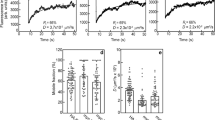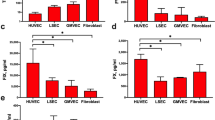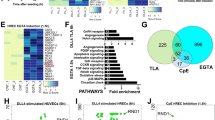Abstract
Endothelial cells expressing fibroblast growth factor receptor-1 (FGFR-1) migrate and proliferate in response to treatment with FGF. We analysed ligand-induced migration and proliferation of porcine aortic endothelial cells expressing wild-type FGFR-1, point-mutated Y766F FGFR-1, unable to activate phospholipase C-γ1 (PLC-γ1), or carboxyl-terminally truncated FGFR-1, lacking either 48 (from amino acid 774 in the FGFR-1 sequence) or 63 (from amino acid 759) amino acid residues of the C-terminal tail. The truncated CT63 FGFR-1 mutant failed to mediate chemotaxis, but was in response to ligand stimulation capable of mediating proliferation of the cells, stimulation of MAP kinase activity and tyrosine phosphorylation of FRS2, an FGFR-1 specific signaling molecule. The defect in migration-capacity of CT63 was not due to loss of Y766, and thereby PLC-γ1 activation, since cells expressing the mutant Y766F FGFR-1 migrated as efficiently as the wild-type receptor cells. Induction of phospholipase A2 (PLA2) activity by the activated FGFR-1 was dependent on the presence of Y766, and was therefore also not critical for the chemotactic response. Although the FGFR-1 only very inefficiently mediates activation of phosphatidylinositol 3′ kinase (PI 3-kinase), the PI 3-kinase inhibitor wortmannin suppressed wild-type FGFR-1 mediated migration. We conclude that the signal transduction pathway for FGFR-1 mediated migration is independent of phosphotyrosine residues in the receptor and requires activation of a wortmannin-sensitive enzyme.
This is a preview of subscription content, access via your institution
Access options
Subscribe to this journal
Receive 50 print issues and online access
$259.00 per year
only $5.18 per issue
Buy this article
- Purchase on SpringerLink
- Instant access to full article PDF
Prices may be subject to local taxes which are calculated during checkout
Similar content being viewed by others
Author information
Authors and Affiliations
Rights and permissions
About this article
Cite this article
Landgren, E., Klint, P., Yokote, K. et al. Fibroblast growth factor receptor-1 mediates chemotaxis independently of direct SH2-domain protein binding. Oncogene 17, 283–291 (1998). https://doi.org/10.1038/sj.onc.1201936
Received:
Revised:
Accepted:
Published:
Issue Date:
DOI: https://doi.org/10.1038/sj.onc.1201936



